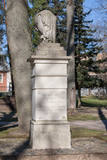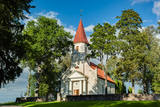| Нo | Название | Описание |
|---|---|---|
|
В исторических источниках Дагда упоминается в XVII веке торговый посад. В 1772 году Дагдский край был включен в Псковскую губернию, а в 1802 г. - в состав Витебской губернии. В 1905 году здесь происходили широкие крестьянские бунты, во время которых были разорены многие важные архитектурные памятники. Город не уберегся и во время двух мировых войн. Что посмотреть туристам? В центре Дагды сохранилась историческая застройка 20 века - дома, построенные из красного кирпича, т.е. «дома еврейских торговцев». Дагда - это единственное место в Латвии, где ежегодно в городском парке празднуют день Анн! |
||
|
В 1877 году, отдавая дань заслугам предков в создании Нейбаде, барон Август фон Пистолкорс велел соорудить в парке памятник. После Первой мировой войны, в 30-е годы, памятник случайно был обнаружен при очистке русла реки Кишупе. Общество помощи и благоустройства Нейбаде памятник восстанавливает и в 1933 году его заново открывают. Памятник пострадал и после Второй мировой войны. В настоящее время памятник восстановлен и находится в парке эстрады. |
||
|
Усадьба Астрава представляет собой один из ярчайших образцов литовской архитектуры в стиле романтизма XIX в. Она находится в Астраве, на полуострове озера Ширвена. До нее легко добраться пешком из Биржай по самому длинному в Литве деревянному пешеходному мосту через озеро Ширвена. Парк площадью 18 га смешанной планировки был здесь разбит в 1851–1862 гг. В парке растут местные растения: ели, сердцевидные липы, сосны. |
||
|
В пейзажном стиле парк был создан во второй половине 18-го века и начале 19-го века. Инициатором создания парка был владелец Алуксненского имения барон Отто Герман фон Фитингоф. В обширном пейзажном парке можно осмотреть значимые малые архитектурные формы – павильон Александра, храм древнегреческого бога ветров Эола, Пальмовый дом, гранитный обелиск О. Г. фон Фитингофу, установленный в 1799-м году, мавзолей рода баронов, бассейн фонтана, сделанный из одного гранитного куска и гранитные скамейки. Алуксненский дворцовый парк считается одним из красивейших парков в Видземе. |
||
|
Viena no ciema augstākajām būvēm. Koka vējdzirnavas cēla 1930. g. un ar vēja palīdzību darbināja septiņus gadus (vēlāk ar elektromotoru). Pie dzirnavām atrodas Jūrmalciema tūrisma informācijas punkts, stends un atpūtas vieta. Turpat redzami veco, zvejnieku pamesto liellaivu koka korpusi. |
||
|
Историки говорят, что ливы на территории древней Латвии были известны еще с Х века. Они населяли Северное Курземе, низовья Даугавы и Гауи, и местность от Гипки до Овиши, где до сих пор можно найти приморские рыбацкие поселки ливского происхождения. Приморские жители всегда питались приготовленной разными способами морской, речной и озерной рыбой: копченой камбалой, салакой, треской, лещом и бельдюгой, жареной миногой, соленой килькой, салакой и сельдью. Свежий малосольный балтийский лосось является деликатесом. На углях жарят судака, форель, карпа, сома или окуня целиком. Гости могут принять участие в рыбалке и копчении рыбы. Заказав дегустационный стол, можно попробовать всего по чуть-чуть. Рожь раскрывает свой вкус в ржаном и кисло-сладком хлебе, скландраусисах и даже в блинах и пипаркукас. В Видземе пекут ячневые оладьи. Здесь готовят вкусные блюда из мяса домашней птицы и скота, а к новогоднему столу подают свиной пятачок с горохом или запеченного молочного поросенка. Трактиры предлагают дичь с брусникой, грибами и другими дарами природы. На гарнир подаются осенние корнеплоды, тыква, бобы или перловка. Вкус блюд дополняют невероятно вкусные соусы. Традиционными пирожками, открытыми пирогами, кренделями, яблочными и медовыми тортами можно наслаждаться и по праздникам, и в обычные дни. Очень вкусны десерты из ржаных панировочных сухарей, клюквы, брусники и сливок. В Курземе популярны также черничные клецки, летом здесь готовят множество десертов со свежими ягодами. Силу природы и здоровье дарят душистые травяные чаи и мед. Головокружительные впечатления подарит вам кружка пива или дегустация домашнего вина. |
||
|
Trīs lielāka izmēra laukakmeņi – aizsargājami dabas pieminekļi, kas atrodas Matsalu līča krastā starp Sāstnas (Saastna) un Metskjulas (Metsküla) ciemiem. Tuvējā ceļa malā ir izvietots informācijas stends un norādes, bet līdz akmeņiem var nokļūt pa iezīmētu taku. Pēc kāda tautas nostāsta, lielas vētras laikā, kas notikusi Jaungada naktī, lielais akmens sašķēlies trīs daļās. No tā arī cēlies vietvārds. Apkārtnē redzamās pļavas ir nozīmīga daudzu augu sugu dzīves vide un svarīga putnu ligzdošanas un atpūtas vieta. Šī iemesla dēļ taku drīkst apmeklēt tikai no 1. jūlija līdz septembra beigām. Akmeņi ir arī labi redzami no minētā ceļa. Tie ar ledāju atceļojuši no Turku (Somija) apkārtnes. |
||
|
Один из важнейших справочных объектов природного парка, который обустроен в столетнем, характерном для исторического края Селии хуторе. Здесь предоставлена возможность ознакомиться с посвященной парку экспозицией, приобрести изделия местных ремесленников и крестьян, а также отведать настойку из бобровой струи! На севере и востоке от «Гулбьи» находится загон острова Путну (250 га) с домашними животными, которые приспособились к жизни в дикой природе – лошади породы Коник и коровыпородыХайлендер. На берегу озера Скукю, на расстоянии 0,5 км установлена вышка для наблюдения за птицами.
|
||
|
On the right bank of the River Pēterupe is one of the historical areas of Saulkrasti – Pēterupe Village. It is believed that the village began to form around a chapel during the so-called Swedish or Catholic times. The chapel was named after the Apostle St. Peter, and therefore the river and the village also carries his name. Pēterupe Village can be considered the oldest village in the Saulkrasti region. The oldest witnesses of the origin of Pēterupe Village are: Rectory, Pēterupe Evangelical Lutheran Church, Outpatient Clinic and the wooden buildings in the old village centre. |
||
|
Pastāv uzskats, ka tieši Rubenē izveidojusies pirmā latviešu draudze. Baznīcas altārdaļa būvēta jau 14.gs., bet pati baznīca savu pašreizējo izskatu ieguvusi 1739. gadā.Būtiska baznīcas interjera sastāvdaļa ir Ķieģeļu muižas mantinieces Barbaras Helēnas fon Budbergas 1762. gadā dāvinātais kroņlukturis ar Krievijas impērijas divgalvaino ērgli un zaru ornamentiem uz bumbas. Baznīcā redzama arī zīme (1869. g.), kas ir veltīta pusgadsimtam kopš dzimtbūšanas atcelšanas. Pastāv vairākas teikas par Rubenes baznīcas nosaukuma rašanos. Viena no tām vēsta, ka, sargājot baznīcu no velna, tās sienā iemūrēta sieviete un vīrietis, kura vārds bijis Rubens. Baznīca esot nosaukta viņam par godu.Vēl viena versija vēsta, ka baznīcas nosaukums cēlies no rubeņa, kas sēdējis kādā no kokiem, kas vēlāk izmantots baznīcas celtniecībā. |
||
|
The tour starts at Jaunmokas Castle estate, where you will also find the Forest Museum. The pride of the castle is its unique painted tile stove (beginning of the 20th century) made of 130 painted tiles featuring 50 different views of the cities Rīga and Jūrmala. The Forest Trails runs along smaller tracks through the Austrumkursa Uplands, the valley of the river Slocene, along Lake Sekļa and Lake Jumprava to finally reach the town of Tukums. Well, the town takes pride in its pots, planters and flower beds with blooming roses along its streets. Next, the route meanders through forests to the demanding hillock of Milzkalns and Lake Valguma, where you will find the barefoot trail and a secluded art space within the woods. The Forest Trail continues to make a stopover at the Ķemeri National Park. The park is dedicated to protection of wetlands, since it is home to one of the largest marshlands of Latvia – the Great Ķemeri bog. As to the town – Ķemeri – it is the former balneological and sulphur springs resort. The tour ends in the village of Bigauņciems, where the Forest Trail joins with the Baltic Coastal Hiking Route (E9 European long distance path). Optionally, one can take a detour along the Lake Sloka trail with its bird-watching tower or pay a visit to the “Forest House” – the visitor’s centre of the Ķemeri National Park. |
||
|
This is the thickest English oak (Quercus robur) in Lithuania, with a circumference of 9.4 m (as opposed to the Kaive oak in Latvia, which has a circumference of 10.18 m).
|
||
|
Жилое здание построено в начале XVIII в., а в середине XIX в. было перестроено. В самой усадьбе священника и в комплексе все еще ведутся восстановительные работы. С сентября 2009 года в комплексе имения священника работают три дома отдыха реколекционного центра Латвийской Евангелическо-лютеранской церкви. Рядом виднеются развалины старой конюшни. |
||
|
В хозяйстве можно понаблюдать за лошадьми, козами, кроликами, собаками, кошками и сурками. Предоставляется возможность поучаствовать в сельскохозяйственных работах и опробовать орудия труда, выучить шаги старинных танцев, пройти по тропам животных и насладиться вкусом жаренных на костре блинов с козьим молоком. В хозяйстве имеется баня, предлагаются травяные чаи. |
||
|
Находится на острове Пилс между Лиелупе и Дриксу. Построенный в стиле барокко дворец проектировал известный итальянский архитектор Франческо Бартоломео Растрелли, что является его наиболее значительной работой раннего творчества. Во дворце находится Латвийский сельскохозяйственный университет. В 1968 г. здесь создан музей.+ 371 63005617. В юго-восточном крыле цокольного этажа дворца расположены родовые гробницы правителей Курземе и Земгале – Кетлеров и Биронов (период времени с 1569 по 1791 гг.), где к осмотру представлены 18 отреставрированных саркофагов. |
||
|
SIA "3x9 zālītes" piedāvā ļoti plašu klāstu zāļu tējas un to maisījumus. Zālītes ievāktas Vecpiebalgas novadā, ekoloģiski tīrās pļavās un mežos. Zālītes vāktas atbilstoši dabas ritmam un mēness fāzēm. Kaltētas dabīgos apstākļos, saglabājot zālīšu vērtīgās vielas, smaržu un garšu. |
||
|
Ziemciešu audzētava „Puķu lauki” ir ģimenes uzņēmums, kurā audzē un piedāvā dekoratīvos stādus. Saimniecība ir specializējusies konkrētu augu grupu audzēšanā. Tās laukos bagātīgi zeļ ziemcietes, graudzāles (zāļveida ziemcietes) un dažādas cirpto bukšu formas. Turklāt, šejienes augu šķirnes ir pielāgotas mūsu klimatiskajiem apstākļiem. Apmeklētāji var izstaigāt skaisti iekopto un ainavisko paraugdārzu, kā arī iegādāties stādus plastmasas konteineros visas sezonas garumā. |
||
|
Rīgas – Daugavpils šosejas (A 6) malā (vietā, kur no Zemkopības institūta nogriežas ceļš uz Skrīveriem) redzama zema ieplaka ar Kraukļu akmeni, kas ir sena kulta vieta. Pie akmens veikti arheoloģiskie izrakumi, kuru laikā atrastas senlietas. Vecākā ir no 12. gadsimta. Akmens aprakstīts slavenajā Andreja Upīša (1877. – 1970.) darbā „Sūnu ciema zēni”. |
||
|
Одно из крупнейших в Курземе хозяйств мясо-молочного животноводства (стадо ~ 500 голов). В вольерах выращивают и большую часть из встречающихся в Латвии домашних птиц. Предлагается познавательная экскурсия, можно приобрести мясо животных, молоко и яйца. |
||
|
This ancient river valley stretches from Koorvere to the Otteni Windmill, and there are nearly 40 revealed sandstone cliffs from the Devonian age. Two of them, Väike and Suur Taevaskoja (the latter is 22 m high) are popular tourist destinations.
|
||























